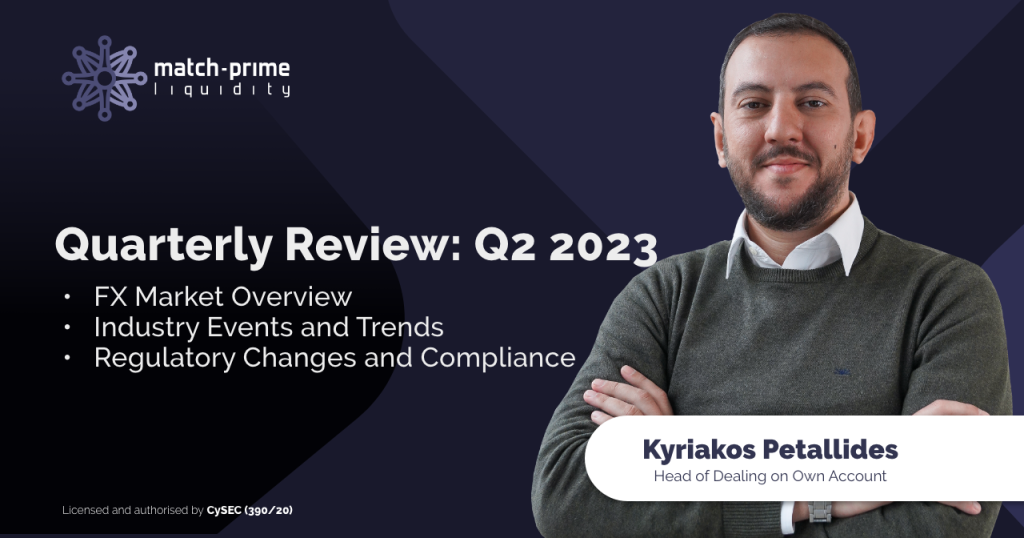
This FX quarterly review presents a comprehensive overview of the global Foreign Exchange market in Q2 2023 with a focus on key events, trends, and regulatory changes as well as projections for the next quarter.
Within this piece, we’re exploring the interest rate policies of prominent central banks including the US Federal Open Market Committee (FOMC), the European Central Bank (ECB), and the Bank of England (BoE), and their potential ramifications on the FX market. It also features a summary of noteworthy industry events, regulatory changes, and compliance initiatives that are currently shaping the financial environment. From significant fines imposed on financial institutions to increased interest rates, this FX quarterly review aims to present the entire financial landscape in the second quarter of 2023.
I. Foreign Exchange (FX) Market Overview
Interest Rates
The first section of our FX quarterly review is dedicated to interest rates. The US Federal Open Market Committee (FOMC) raised them by 0.25 percent in the meetings held in March and May. In June, Fed decided to keep rates unchanged, taking a pause to evaluate the economic consequences of the previous rate hikes. The rate announcement and comments from Fed Chair Jerome Powell suggest that, despite the suspension, it is expected that two more rate hikes will happen before the year ends.
The European Central Bank (ECB) increased interest rates twice during the quarter, bringing the main refinancing rate to 4%.
The Bank of England (BoE) raised rates twice, in May and June. The 0.5 percentage points (pp) increase in June represented a reacceleration in rate hikes after an initial decision to slow the pace in March to 0.25 pp increments.
Global Equity Market
Time for the next section of our FX quarterly review: equity markets. Japan had the best performance among major equity markets in both the quarter and the first half of the year, with gains of 14% and 23% respectively in local currency terms. The weakening of the Yen against other major trading partners contributed to the strength of Japanese stocks.
US stocks performed well, with a 9% gain over the quarter and a 17% gain for the year to date in local currency terms. The gains in US stocks were primarily driven by the largest growth stocks, particularly in the technology sector, which are primarily found in the US market.
Hungary, Poland, and Greece were the top-performing index markets, even as recessionary concerns in Europe increased. Central European markets started anticipating rate cuts as inflation eased, and Hungary actually implemented a rate cut in June. Greece’s outperformance was due to the ruling New Democracy party winning a second term in office in May, indicating a continuation of market-friendly policies.
China underperformed due to concerns about a slower-than-expected economic recovery. Kuwait and Qatar also lagged in performance. South Africa was one of the worst performers due to a deteriorating power situation, which negatively impacted economic growth. Turkey saw the largest loss in US dollar terms, coinciding with President Erdogan’s re-election in May, extending his long-standing rule.
Global Fixed Income
Another part of oue FX quarterly review is global fixed income. High-yield credit and Italian government bonds have been the best-performing fixed-income assets this year, both returning around 5%. These assets benefited from their higher starting yields and economic flexibility.
UK Gilts, on the other hand, have been the worst-performing ones, experiencing a decline of just under 4%. UK Gilts suffered due to ongoing inflation concerns, leading markets to price in a higher interest rate peak of around 6% and anticipate a longer period of elevated rates.
US Dollar
During the 2nd quarter of 2023, the USD retreated compared to majors, EUR (0.92%), GBP (2.38%), and CAD (1.89%) and gained compared to Gold and the Japanese Yen. The US Dollar was unmoved in comparison with the Australian and New Zealand Dollar.
By the end of Q2 2023, the DXY (Dollar Index) was trading at around $103, slightly lower compared to the end of 2022. In June, the dollar weakened by 1.4%, but it showed a 0.78% increase by the end of the second quarter.
II. Industry Events and Trends
CFTC Fines HSBC $45 Million
Let’s start the events and trends section of our FX quarterly review with a loud newspaper story. The Commodity Futures Trading Commission (CFTC) has fined HSBC $45 million for engaging in manipulative and deceptive trading practices. HSBC utilized the tactic of “spoofing” in precious metals futures markets from 2008 to 2014. The bank’s traders coordinated with each other and employed sophisticated algorithms to carry out these deceptive activities.
The CFTC found that HSBC’s spoofing activities influenced and distorted market prices, giving them an unfair advantage. HSBC has cooperated with the CFTC, enhanced internal controls, and agreed to implement measures to detect and prevent spoofing. The enforcement action reflects the CFTC’s commitment to combat market manipulation and ensure fair trading practices.
Top 25 Banks Market Capitalization
The combined market capitalization of the top 25 global banks has reached $33 trillion in Q2 2023. This represents a significant increase compared to previous quarters. The change was driven by various factors including improved economic conditions and investor optimism.
The top three banks in terms of market cap were JPMorgan Chase, Bank of America, and Industrial and Commercial Bank of China. They benefited from strong performance in investment banking divisions and robust capital markets activity.
This market capitalization increase indicates investors’ confidence in the banking sector’s growth prospects. However, regulatory challenges, low interest rates, and potential economic uncertainties could still impact future performance.
VC Funding: Artificial Intelligence
Another case worth mentioning in our FX quarterly review is VC funding for AI projects. Compared to previous quarters, financing decreased. It may, potentially, lead to a slowdown in the entire startup ecosystem.
The decline in funding is attributed to factors such as economic uncertainties, regulatory challenges, and shifting investor sentiment. However, sectors such as healthcare and technology still attracted significant funding despite the overall decline.
In the first half of 2023, companies categorized by Crunchbase as AI secured a total of $25 billion in funding, which accounted for 18% of the global funding. Notably, OpenAI received a significant $10 billion investment led by Microsoft in January. While it is less than the $29 billion invested in H1 2022, it represents a higher proportion of the overall funding.
Inflection AI, a machine-learning startup, raised an impressive $1.3 billion in the last quarter. Other AI companies that secured substantial funding in Q2 included Anthropic, CoreWeave, Cohere, Builder.ai, and Runway.
Furthermore, companies operating outside of the AI sector also raised significant funding rounds. Notable examples include the Chinese fast fashion retailer Shein, German solar and smart electricity company 1Komma5°, and Swedish battery manufacturer Northvolt.
Celsius CEO Fined by the FTC/SEC
The former CEO of Celsius Alex Mashinsky and former CRO Roni Cohen-Pavon are facing charges of securities fraud, commodities fraud, wire fraud, conspiracy, market manipulation, and more. They are accused of manipulating the price of the Celsius token and misappropriating over $4 billion in consumer assets.
Mashinsky was arrested, and the indictment includes seven criminal counts. The Commodity Futures Trading Commission filed a complaint against Celsius, seeking a $4.7 billion fine, while the SEC has also filed a lawsuit against the company. Celsius is cooperating with regulators, but Mashinsky has pleaded not guilty to misleading customers and inflating the CEL token.
III. Regulatory Changes and Compliance
European Commission Updates List of High-Risk Third Countries
Let’s move on to the legal section of our FX quarterly review. On May 17, 2023, the European Commission made updates to the list of high-risk third countries under the Fourth Money Laundering Directive (MLD4). The update involves the addition of Nigeria and South Africa to the list due to their strategic deficiencies in anti-money laundering and countering terrorism financing (AML/CTF) measures. Conversely, Cambodia and Morocco were removed from the list. The Delegated Regulation containing these changes will be reviewed by the Council and the European Parliament. If neither objects, it will become effective 20 days after its publication in the Official Journal.
European Banking Authority Consultation on Amendments to the Guidelines on ML/TF Risk Factors
The European Banking Authority (EBA) is conducting a consultation on the proposed amendments to the guidelines on money laundering and terrorist financing (ML/TF) risk factors. The amendments aim to provide new sector-specific guidance for Crypto Asset Service Providers (CASPs).
This guidance will highlight the factors that indicate the CASPs’ exposure to higher or lower ML/TF risks. CASPs are advised to consider these factors when assessing the ML/TF risks of their business and customers, both at the beginning and during the business relationship. The guidelines also outline how CASPs should adjust their customer due diligence (CDD) procedures based on these risks. Additionally, the amendments guide other credit and financial institutions on the risks they should consider when entering into a business relationship with a CASP or dealing with crypto assets in other ways.
EBA Guidelines on Information and Communication Technology (ICT) and Security Risks Management
The guidelines focus on addressing information and communication technology (ICT) and security risks, emphasizing the need for cybersecurity measures within CIFs’ information security practices. CIFs are expected to comply with these guidelines by 31st December 2023. Compliance involves establishing governance and internal control frameworks for managing ICT and security risks, conducting internal audits of related activities, and obtaining the approval of the Board of Directors for the audit plan.
That’s it for this FX quarterly review. If you liked it, take a look at the report from the previous quarter as well as Q3 2023.

